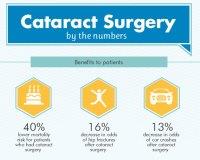Analyzing The Advantages And Negative Aspects Of Typical Cataract Surgical Treatment Versus Laser-Assisted Methods
Analyzing The Advantages And Negative Aspects Of Typical Cataract Surgical Treatment Versus Laser-Assisted Methods
Blog Article
Uploaded By-Bush Eriksen
When considering the option in between standard cataract surgery and laser-assisted techniques, you might find yourself evaluating the benefits and downsides each method provides. The choice goes beyond the surface area degree of price and accuracy, delving right into the world of lasting end results and patient satisfaction. As read what he said navigate with the intricacies of these two methods, it ends up being critical to comprehend the nuanced details that can considerably influence your visual clarity and overall experience. Stay tuned to uncover the critical variables that will certainly lead your decision-making procedure in this critical element of eye treatment.
Traditional Cataract Surgical Treatment Pros and Cons
When considering standard cataract surgical treatment, you may discover that it's a well-established and widely-used technique. In this treatment, a cosmetic surgeon makes a tiny incision in the eye and makes use of ultrasound to break up the gloomy lens prior to removing it. Once the cataract is gotten rid of, an artificial lens is placed to recover clear vision.
Among the major advantages of standard cataract surgical treatment is its performance history of success. Numerous clients have had their vision significantly improved with this treatment. In addition, standard surgical treatment is commonly covered by insurance, making it a much more available option for numerous individuals.
However, there are some drawbacks to traditional cataract surgical treatment as well. Recuperation time can be much longer compared to more recent methods, and there's a slightly higher danger of issues such as infection or swelling. cataract surgery when can i go back to work may additionally experience astigmatism or need analysis glasses post-surgery.
Laser-Assisted Techniques Pros and Cons
Exploring laser-assisted strategies for cataract surgical procedure unveils a modern-day method that utilizes laser technology to execute key action in the treatment. Among the primary benefits of laser-assisted cataract surgery is its accuracy. The laser allows for extremely accurate lacerations, which can lead to far better visual end results. Additionally, the use of lasers can minimize the quantity of ultrasound power required throughout the surgery, possibly reducing the threat of difficulties such as corneal damage.
On the drawback, laser-assisted methods can be more pricey compared to typical approaches. This price mightn't be covered by insurance policy, making it less easily accessible to some clients.
Another consideration is that not all cataract surgeons are trained in laser modern technology, which could restrict your alternatives for choosing a doctor.
Lastly, while the laser can automate particular elements of the treatment, the surgical treatment still calls for an experienced specialist to ensure effective outcomes.
Comparative Evaluation of Both Techniques
For a comprehensive understanding of cataract surgical treatment methods, it's necessary to perform a relative analysis of both typical and laser-assisted approaches.
Conventional cataract surgical treatment entails hand-operated incisions and making use of handheld devices to separate and remove the over cast lens.
On the other hand, laser-assisted cataract surgical treatment utilizes innovative modern technology to produce accurate lacerations and separate the cataract with laser power prior to removing it.
In terms of precision, laser-assisted methods supply a higher degree of precision contrasted to standard approaches. Using lasers enables customization of the treatment based on each patient's eye anatomy, potentially bring about far better aesthetic end results.
Nonetheless, laser-assisted cataract surgical treatment tends to be more pricey than standard surgery, which might limit availability for some individuals.
While both approaches work in restoring vision damaged by cataracts, the option between standard and laser-assisted strategies usually depends upon elements such as cost, precision, and specific person needs.
Consulting with your eye doctor can help determine the most ideal strategy for your cataract surgical treatment.
Conclusion
In conclusion, when determining in between typical cataract surgical procedure and laser-assisted techniques, consider elements like expense, accuracy, and specific requirements. Typical surgery uses a tried and tested record and insurance coverage but may come with longer healing times. Laser-assisted techniques offer higher accuracy and personalization however can be much more pricey and not always covered by insurance coverage. Ultimately, the choice in between the two methods depends on what is crucial to you and your details situation.
